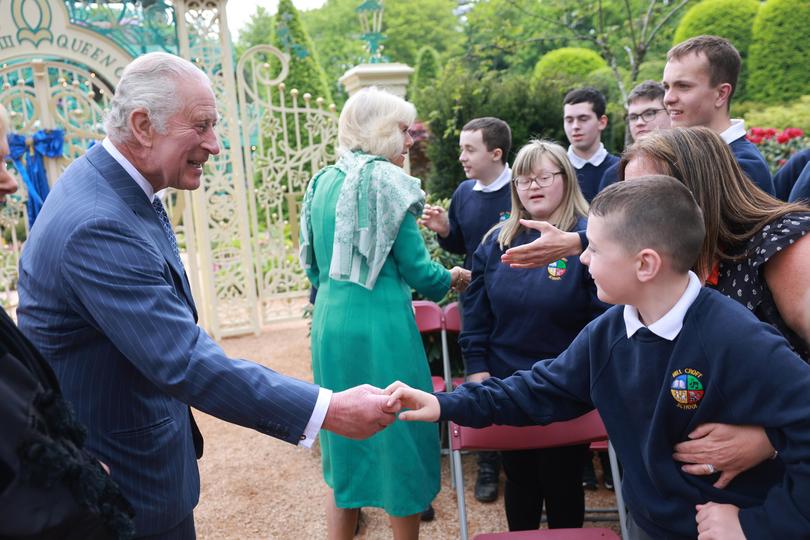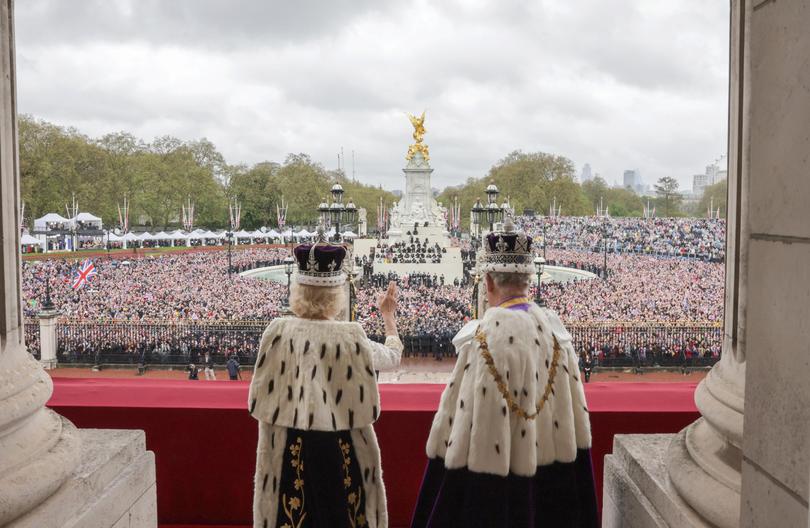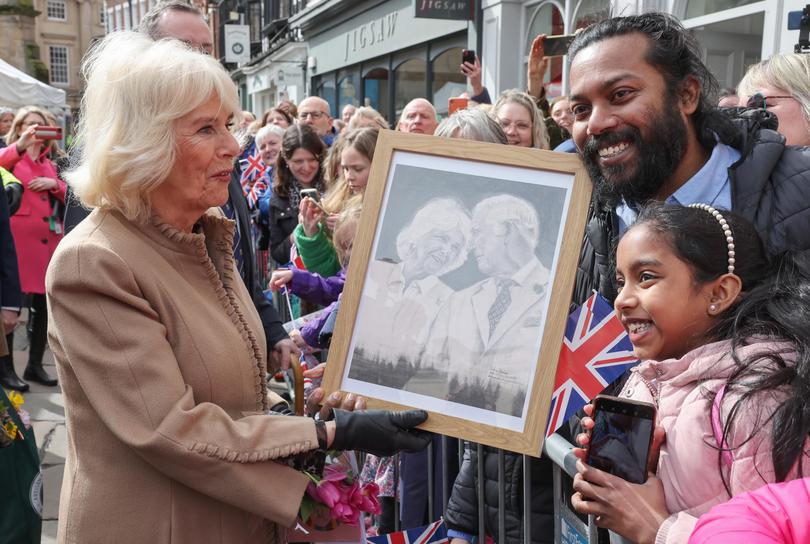How King Charles’ and the royal family’s challenges may have revitalised them in the public eye

One year ago, the choirboys’ cry of “Vivat Rex Carolus” echoed through Westminster Abbey. The new King and his Queen were crowned, robed in white and gold against the deep red of their thrones. In the official portraits, taken at Buckingham Palace afterwards by Hugo Burnand, they wear the full weight of the Imperial State Crown and Queen Mary’s Crown.
This was the pinnacle of the monarchy’s pomp and ceremony: they could hardly look more regal.
A year on, as they mark the first anniversary of their Coronation, the image is rather different. Arm in arm, dressed about as casually as the King is ever seen, the couple are pictured strolling through a spring garden with blossom in the background and smiles on their faces. King and Queen, husband and wife. It has been quite the year.
Sign up to The Nightly's newsletters.
Get the first look at the digital newspaper, curated daily stories and breaking headlines delivered to your inbox.
By continuing you agree to our Terms and Privacy Policy.For much of the year, we now know, the King has been unwell; he and the Princess of Wales on their eerily similar journeys from hospital to the discovery of cancer, the public statement, and the treatment that kept them at home. The “kind thoughts” of the nation, the King said, have been the “greatest comfort and encouragement”.
It was not how the first years of the reign of King Charles III were supposed to unfold. But with loss – of health, of freedom, of contact with the public – the monarchy has seemingly gained something new. The Royal family are more human than they have ever been. From hugs to handholding, something has shifted in the public imagination. The era of Queen Elizabeth II – still described at the Palace as a “quasi deity” – is over, and the reign of her son is underway.
Where once there was deference, there is familiarity: the King is often greeted out and about with “hello, Charles”. The curtseys are swapped, more often than not, for selfies. Four days after that anniversary spring garden photograph was released, the King made his first official public engagement since his cancer diagnosis, holding the hands of fellow patients as they had their own chemotherapy.
Not since the Queen Mother met news of the palace being bombed during the Blitz as a chance to “look the East End in the eye” has the Royal family faced such a moment. The Royal family then – George VI, Queen Elizabeth, and the young Princesses Elizabeth and Margaret – were transformed as the faces of a resilient nation united against Hitler. More than 70 years later, when the Covid-19 pandemic struck and they were seen working via video calls along with the rest of Britain, something shifted again.
But it is in the King’s own adversity, cancer at the age of 75, that he has found a new way to connect with people as equals, in that great, unwelcome leveller of ill health. He, too, can look anyone affected by cancer – most of the country, in one way or another – in the eye.
“He is literally as well as figuratively reaching out to people, happy to embrace them and hold their hand,” says a Palace source. “The more people see of him and her [Camilla], the more they see they are warm and engaging on a human and personal level, in a slightly new way for a monarch.”
“From crisis can arise opportunity,” says Prof Tracy Borman, historian and author of Crown & Sceptre: A New History of the British Monarchy. “It has proved in the past to be a real moment for the monarchy to align with its people.”
Historically, she says, there has been “unease” when a “very long reign comes to an end, and people adjust to a new one”, pointing to Elizabeth I and Queen Victoria as examples. “There have actually been quite a lot of moments in the history of the Crown where there is a fundamental change in how the monarchy and the public relate to each other.”
The question the monarchy must constantly answer, with the help of the Palace machine, is what do the public want from their royals? How do they remain relevant? For example, the very notion that princes and princesses should be “relatable” was not a requirement for the late Queen’s generation; on the contrary. Today, however, for Gen Z, it seems essential.
It is not the first time that cancer has changed the course of Royal history. The death of George VI, who had lung cancer, brought the young Princess Elizabeth to the throne decades before either of them had hoped. Back then, his diagnosis was a secret.
This time, his grandson’s illness has been faced head on: first a statement about enlarged prostate symptoms, then the revelation of a second, more serious discovery of cancer. The decision to reveal the diagnosis, though not the specific cancer or treatment, was made ultimately by the King himself, with the support of the Queen and a small circle of advisors.
It was not the result of hours of meetings, one source says, but a personal instinct that the royal openness could help others.
Having authorised an unprecedented Palace statement about his enlarged prostate symptoms, the stakes were raised when a new verdict of cancer came in. But “having been greatly reassured and encouraged by the response to the initial news, it seemed the natural thing to do to use the greater challenge for even greater good,” a source says.
The King has since drawn strength from hearing from charities about a rise in public awareness and people seeking help for symptoms, calling it “heartening”. Six weeks later, of course, the Princess of Wales made her own personal statement, filming a heartfelt video to deliver the raw, emotional news that she was having chemotherapy. The history books will show 2024 as a turning point in the monarchy’s relationship with its public.

Yet the double illness accelerated a process that was already underway. The moment of the King’s accession, upon the death of his mother on September 8 2022, had preoccupied the minds of courtiers for years, if not decades. How would the public get over the loss of a Queen – among the last of her wartime generation – so embedded in the national identity? And how would a King who had lived his entire life in the headlines and whose reputation preceded him, fare in inevitable comparison?
When the moment came, the planning paid off, and the worry came to nothing. “The story, actually, was how well this had gone,” reported an aide not long afterwards. The warmth of the public’s reception for the King was front and centre of his first few weeks in the top job. Outside the gates of Buckingham Palace one woman asked if she could give him a hug. “Of course,” he replied.
Sir Clive Alderton, the King’s private secretary, was so struck by the moment that he reported it back to Palace staff and told them it encapsulated the “informal formality” of the new reign. “The late Queen was from a different generation from a different era, rightly revered,” says a Palace source. “Attempting to fill her shoes was going to be an impossible task because she was unique and distinct.
“But that was never the plan,” the source added. “I think people thought it would be the plan but it wasn’t. It has taken a while for that to sink in.”
“We’ve been witnessing an informal formality to King Charles III since the very start of his reign, with the monarch glad-handing members of the public in a way that his late mother never would – or indeed could – have done,” says Joe Little, the managing editor of Majesty magazine.
“The Prince of Wales also interacts with members of the public in a more relaxed way these days, and we are now accustomed to seeing him – and more surprisingly his uncle Edward, the Duke of Edinburgh – turn up tie-less at some official engagements, particularly those involving young people,” he adds.
By the time of the Coronation, on Saturday, May 6 2023, the talk was of how the King wanted to emphasise his “service”: to the nation, realms and Commonwealth. “Obviously, the whole spectacle looked and sounded impressive, showcasing the very best of our musical, military, and political traditions,” says Penny Mordaunt MP, whose role as Lord President of the Council has her in close, regular contact with the King, and saw her wielding a large sword throughout his Coronation ceremony.
“But I’m most struck by the way the day embodied something far more humble, the value of service rooted in our national character,” she continues. “In all the pomp and pageantry, it’s easy to forget that at its heart, the Coronation service has deep religious and constitutional significance. I got a very real sense of that in the Abbey. Despite the scale of the day, it felt intimate and sacred.”
After the pomp and ceremony drew to its close, and images of sceptres, crowns, marching military bands and a Royal family in its finery flew around the world, two further images were released. Taken behind-the-scenes at Buckingham Palace, one showed the King’s eye view from the palace’s balcony, monarch and consort looking outwards. The other, in which they are in their crowns smiling with relief, sees them at ease. This was the real story of the humans at the heart of it.

Christopher Jackson, the Getty royal photographer, who was invited to capture the moment, said the pictures – which he jokes gave him “sleepless nights” in advance – are intended to give the public a “front row seat to history”.
“I wasn’t entirely sure what to expect but I knew I wanted to give the viewer an insight into this special day,” he says. “This never-seen-before perspective would certainly give the viewer a glimpse of the Royal perspective, looking out across a sea of cheering public while encompassing the elements of Crown and crowd.” That he was allowed to do so is a sign of the times.
Kensington Palace also moved the dial. A home video, showing the young Wales family getting ready and leaving home for the big day, was posted on social media: Prince George, Princess Charlotte and Prince Louis seen gasping as they looked out of the carriage window on their journey through London. The public was being let in on the magic.
As the country settled into the era of King Charles, with coins, stamps and Christmas speeches changing, so, too, the Royal family bedded into their new roles. Prince William stretched his legs a little with a forthright statement about the conflict in Gaza and said, during a trip for his Earthshot Prize, that he wants to “go a step further” than his predecessors to “actually bring change” for his causes.
“They’re at their best when they’re at the heart of local communities, talking to people face to face,” a source said, of the Prince and Princess of Wales. “They want people to feel comfortable when they meet them.”
The social media posts from both palaces have been noticeably slicker, the Royal family now expected to be “content creators” on top of their constitutional and charitable roles. Hugs and high-fives happened so often they were no longer remarkable. Even Princess Anne agreed to join a podcast. “As the year has worn on,” notes a palace source, “there has been less ceremony and more grass roots.”
Buckingham Palace and Balmoral, quite literally, are being opened up to the public, with more rooms on show in line with the King’s wishes. Since news of the King and Princess’s illness, the tone of engagements has softened yet further.
In a charity kitchen in Sunbury-on-Thames, for instance, volunteer Rachel Candappa handed Prince William one of the many homemade cards that wellwishers had sent for his wife, and asked him to look after her. “I will,” he told her, with a reassuring hand on her shoulder. And in a walkabout in Shrewsbury, the extent and warmth of crowds for Queen Camilla surprised even the Palace.
A concerted effort from campaign group Republic to rally the troops to their cause in the new reign has gained little traction. “Whatever your beliefs and views about monarchy, even if you’re in opposition to it, there’s something slightly distasteful about turning out to effectively jeer at a 76-year-old woman whose husband is poorly, whose daughter-in-law is poorly, and who is doing her best to cheer everyone up,” one Palace source says. “It just feels on a human level to be unpleasant.”
Cards and letters sent for the King were acknowledged not just by a thank-you letter in return, but by images of him chuckling over their jokes and a confession that some left him in tears.
At the University College Hospital Macmillan Cancer Centre this week, a small adjustment to the programme barely got a mention. It has been a tradition for royal engagements to include small children handing over posies to a visiting Queen or King. This time, however, Charles and Camilla passed back presents for them, too. It seemed strange, suddenly, that it hasn’t always been the case.
“It’s a spontaneous thing,” says a source, of the King’s approach to increasingly tactile members of the public. “It’s how he is. He loves those engagements where he’s absolutely surrounded by people. If he didn’t like it, it wouldn’t be happening.”
The current attention on King Charles, adds a friend, has meant “people have seen those character traits that have perhaps not been so publicly visible previously”. “It’s not that anything’s changed, it’s that people are noticing,” the friend continues. “He’s very empathetic, very warm one on one, and with a wicked sense of humour. Perhaps that has shone brighter in dark times.”
The plan from now on, at both palaces, is to stick to the “core themes”, with “authenticity” being viewed as “key”.
Yet there is danger, inevitably, in all this relatability. “There is a risk that excess informality might lead to overfamiliarity,” cautions Little. “If members of the Royal family become too ‘normal’ the institution that they represent will lose its lustre.”
Robert Hazell, professor of government and the constitution at the University College London’s Constitution Unit, warns that “the public want a host of contradictory things”. “We want them to represent tradition, continuity and stability, and then criticise them for failing to keep up with the times,” he says.

“We want them to be role models of good behaviour, while recognising in another part of our brains that they are only human, with frailties like the rest of us. We want Kate to recover after her serious operation, but she is hounded mercilessly on social media for failing to appear. In short, the public are fickle, and want it both ways.”
But, adds Prof Hazell, “One thing going for the monarchy is that different generations can represent different values. Charles can appeal to the older generation, representing the values of tradition and stability, while William and Kate are less formal and may be more relatable to younger people.”
For Penny Mordaunt, the Royal family is “vital to our future, not just our past”. “One year on, people often stop me to talk about the Coronation, and soon enough the conversation turns to their own memories of the day, watching the television with their grandparents, down the local pub, in the village hall,” she tells The Telegraph.
“You see, the Royal family is that gilt thread that stitches us together, provides continuity in our lives, and gives us a sense of something greater than ourselves. That remains true today and long may it continue.”
Polling remains remarkably steady on the future of the monarchy, although any strategist would be mindful of the longstanding trend of the younger generation being consistently less supportive than their elders. “The monarchy is not the self-preservation society,” a Palace source points out. “It’s not about chasing headlines or percentage points in support, it’s a long game. It’s trying to do good things for the nation, realms and Commonwealth.”
In the coming weeks, the King is due to make a steady return to public engagements. Garden parties, any appearance his doctors will agree to at the 80th anniversary of D-Day on June 6, and Trooping the Colour are all on the table. A long-haul trip to Samoa for the Commonwealth Heads of Government Meeting in October is still being provisionally planned.
“I hope that the past year has made the public proud of the King and the King proud of himself,” says one of his friends.
Perhaps oddly, amid all the tradition of monarchy, there is no tradition for kings or queens to celebrate their own coronation each year. Instead, Charles and Camilla will be at Highgrove. Weather-permitting, they will spend the bank holiday gardening. And what could be more relatable than that?
